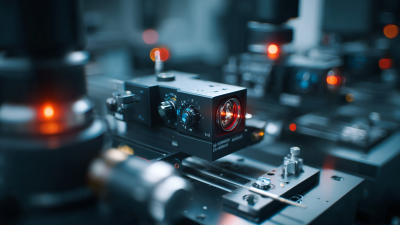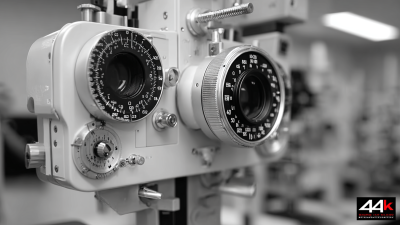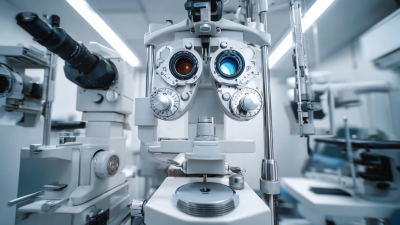Top Strategies for Enhancing Practice Efficiency with Optometry Equipment
In the ever-evolving field of optometry, the efficient use of equipment is crucial for enhancing practice outcomes and improving patient care. The integration of advanced Optometry Equipment not only streamlines daily operations but also boosts clinical productivity and accuracy. As practitioners strive to provide high-quality services in a competitive landscape, exploring innovative strategies for maximizing the benefits of their tools becomes essential.

This blog will delve into top strategies for enhancing practice efficiency with Optometry Equipment, focusing on practical solutions that can drive operational success and elevate the patient experience. From adopting the latest technologies to optimizing workflow processes, we aim to equip optometrists with the insights necessary to leverage their equipment effectively and achieve a thriving practice.
Utilizing Advanced Diagnostic Tools for Improved Practice Workflow
In the rapidly evolving field of optometry, utilizing advanced diagnostic tools is paramount for improving practice workflows. Artificial intelligence (AI) is at the forefront of this transformation, enhancing diagnostic capabilities and streamlining operations, which ultimately leads to better patient outcomes. More specifically, AI is revolutionizing the analysis of diagnostic images, allowing for quicker and more accurate assessments. Reports indicate that practices integrating AI can decrease diagnostic errors by up to 20%, which significantly enhances treatment efficacy.
Tip: Integrate AI-powered tools that provide real-time analysis of diagnostic images. This not only speeds up case management but also reduces the cognitive load on practitioners, allowing them to dedicate more time to patient interaction.
Moreover, the implementation of AI in optometry assists in customizing patient care by leveraging data analytics to identify trends and predict outcomes. As AI systems can process vast amounts of data, they can provide personalized treatment options tailored to individual patient needs.
Tip: Utilize analytics to track patient progress over time. Analyzing this data can enable practitioners to refine their approaches and adapt interventions that are most effective for their patients, resulting in higher levels of patient satisfaction and loyalty.
Streamlining Patient Management with Integrated Optometry Software
In the fast-paced world of optometry, managing patient care efficiently is paramount to ensuring both satisfaction and effective treatment outcomes. Integrated optometry software serves as a game changer, offering practitioners tools for streamlining patient management processes. By utilizing comprehensive systems that encompass appointment scheduling, patient records, and billing, optometrists can reduce administrative burdens and focus more on patient care.
Moreover, such software solutions enable seamless communication between staff and patients. Features like automated reminders for appointments help decrease no-show rates, while secure messaging tools enhance patient engagement and allow for timely updates on care plans. By centralizing information and processes, integrated optometry software not only boosts operational efficiency but also enriches the overall patient experience, making it easier for optometrists to deliver quality care.

Maximizing Equipment Functionality through Regular Maintenance Protocols
Regular maintenance protocols are crucial for maximizing the functionality of optometry equipment and enhancing overall practice efficiency. According to industry reports, equipment failure due to inadequate maintenance can lead to a significant decrease in productivity—up to 30%. Implementing a structured maintenance schedule not only prolongs the lifespan of equipment but also ensures that each device operates at its optimal capacity, reducing downtime and service interruptions.
Furthermore, aligning maintenance practices with technological advancements, such as integrating digital solutions for tracking and managing service schedules, can boost operational efficiency. Research indicates that systematic maintenance can reduce operational costs by approximately 25%, enabling practices to allocate resources more effectively. By investing in preventive maintenance and utilizing data analytics for equipment performance, optometry practices can create a robust framework that not only enhances patient care but also drives profitability and growth in a competitive landscape.
Top Strategies for Enhancing Practice Efficiency with Optometry Equipment
| Strategy | Description | Frequency | Impact on Efficiency |
|---|---|---|---|
| Regular Calibration | Ensures accurate measurements and optimum equipment performance. | Quarterly | High |
| Routine Cleaning | Maintains hygiene and prevents equipment contamination. | Weekly | Medium |
| Software Updates | Enhances features and security of diagnostic equipment. | Monthly | High |
| User Training | Increases staff proficiency and reduces user errors. | Semi-Annually | High |
| Routine Inspections | Identifies potential issues before they become major problems. | Monthly | Medium |
Implementing Telehealth Solutions to Expand Patient Access and Efficiency
In today's fast-paced healthcare environment, implementing telehealth solutions is an essential strategy for enhancing the efficiency of optometry practices. Telehealth not only allows practitioners to reach a broader patient base, but it also streamlines many operational processes. By incorporating virtual consultations, optometrists can reduce wait times and improve patient satisfaction, as individuals can receive care from the comfort of their homes. This flexibility enables greater accessibility for patients with mobility issues or those living in remote areas.
Furthermore, leveraging telehealth technology can optimize resource management within an optometry practice. With the ability to conduct follow-up appointments and routine check-ins online, the physical space in the office can be utilized more effectively for in-person visits requiring specialized equipment. Additionally, telehealth platforms often come equipped with tools for patient education and monitoring, enhancing overall care continuity. By embracing these digital solutions, optometrists can not only expand their reach but also create a more efficient and responsive practice model that meets the evolving needs of their patients.
Training Staff on Equipment Usage to Reduce Wait Times and Errors
Training staff effectively on the use of optometry equipment is crucial for enhancing practice efficiency. When employees are well-versed in the operation of diagnostic and treatment tools, they can perform tasks more swiftly and accurately. This not only minimizes the risk of errors but also streamlines patient flow, significantly reducing wait times. Engaging staff in hands-on training sessions and regular workshops ensures they stay updated on the latest equipment functionalities and best practices, which is key to maintaining a high standard of patient care.
Moreover, creating a culture of continuous learning benefits the entire practice. By encouraging staff to share tips and experiences regarding equipment usage, practices can foster a collaborative environment that prioritizes efficiency and accuracy. Implementing a structured training program that includes both initial onboarding for new hires and ongoing education for existing staff can lead to improved operational performance. Ultimately, a knowledgeable team equipped with the right skills will not only enhance patient experiences but also contribute to the overall success of the practice.

Related Posts
-

Exploring the Features and Applications of Top Optical Equipment for Global Procurement
-

Setting the Benchmark: Understanding Industry Standards for Best Optometry Equipment
-

Understanding the Essentials of Optometry Equipment for Enhanced Vision Care
-

Understanding the Best Screwdriver Bit Options for Every Job
-

Unlocking Global Markets with Best Glasses Chain Export Certification Secrets
-

12 Best Sunglasses Cases for Every Style and Budget in 2023
